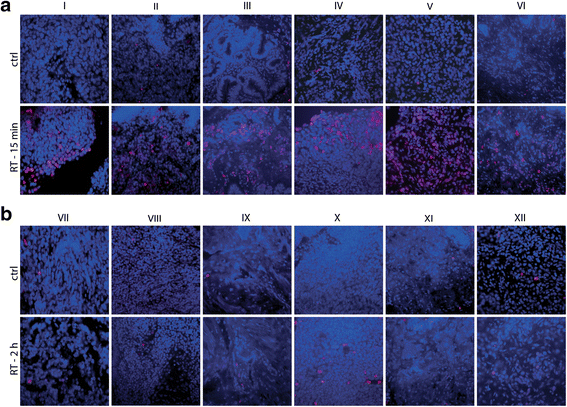A short time interval between radiotherapy and hyperthermia reduces in-field recurrence and mortality in women with advanced cervical cancer
- PMID: 28449703
- PMCID: PMC5408439
- DOI: 10.1186/s13014-017-0813-0
A short time interval between radiotherapy and hyperthermia reduces in-field recurrence and mortality in women with advanced cervical cancer
Abstract
Background: Combined radiotherapy and hyperthermia is a well-established alternative to chemoradiotherapy for advanced stage cervical cancer patients with a contraindication for chemotherapy. Pre-clinical evidence suggests that the radiosensitizing effect of hyperthermia decreases substantially for time intervals between radiotherapy and hyperthermia as short as 1-2 h, but clinical evidence is limited. The purpose of this study is to determine the effect of the time interval between external beam radiotherapy (EBRT) and same-day hyperthermia on in-field recurrence rate, overall survival and late toxicity in women with advanced stage cervical cancer.
Methods: Patients with advanced stage cervical cancer who underwent a full-course of curative daily EBRT and (4-5) weekly hyperthermia sessions between 1999 and 2014 were included for retrospective analysis. The mean time interval between EBRT fractions and same-day hyperthermia was calculated for each patient; the median thereof was used to divide the cohort in a 'short' and 'long' time-interval group. Kaplan-Meier analysis and stepwise Cox regression were used to compare the in-field recurrence and overall survival. Finally, high-grade (≥3) late toxicity was compared across time-interval groups. DNA repair suppression is an important hyperthermia mechanism, DNA damage repair kinetics were therefore studied in patient biopsies to support clinical findings.
Results: Included were 58 patients. The 3-year in field recurrence rate was 18% and 53% in the short (≤79.2 min) and long (>79.2 min) time-interval group, respectively (p = 0.021); the 5-year overall survival was 52% and 17% respectively (p = 0.015). Differences between time-interval groups remained significant for both in-field recurrence (HR = 7.7, p = 0.007) and overall survival (HR = 2.3, p = 0.012) in multivariable Cox regression. No difference in toxicity was observed (p = 1.00), with only 6 and 5 events in the short and long group, respectively. The majority of DNA damage was repaired within 2 h, potentially explaining a reduced effectiveness of hyperthermia for long time intervals.
Conclusions: A short time interval between EBRT and hyperthermia is associated with a lower risk of in-field recurrence and a better overall survival. There was no evidence for difference in late toxicity.
Keywords: Cervical cancer; Clinical outcome; Hyperthermia; Radiotherapy; Time interval.
Figures


References
-
- Lutgens L, van der Zee J, Pijls-Johannesma M, De Haas-Kock DF, Buijsen J, Mastrigt GA van, et al. Combined use of hyperthermia and radiation therapy for treating locally advanced cervical carcinoma. Cochrane Database Syst Rev 2010:CD006377. doi:10.1002/14651858.CD006377.pub2. - PubMed
-
- Eifel PJ, Winter K, Morris M, Levenback C, Grigsby PW, Cooper J, et al. Pelvic irradiation with concurrent chemotherapy versus pelvic and para-aortic irradiation for high-risk cervical cancer: an update of radiation therapy oncology group trial (RTOG) 90-01. J Clin Oncol. 2004;22:872–80. doi: 10.1200/JCO.2004.07.197. - DOI - PubMed
-
- Lutgens LCHW, Koper PCM, Jobsen JJ, van der Steen-Banasik EM, Creutzberg CL, van den Berg HA, et al. Radiation therapy combined with hyperthermia versus cisplatin for locally advanced cervical cancer: Results of the randomized RADCHOC trial. Radiother Oncol. 2016;120:378–82. doi:10.1016/j.radonc.2016.02.010. - PubMed
MeSH terms
LinkOut - more resources
Full Text Sources
Other Literature Sources
Medical

